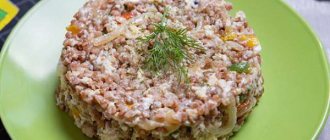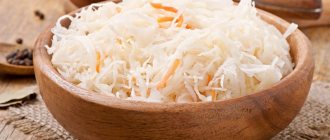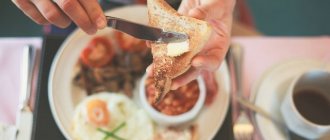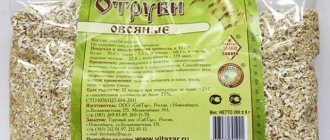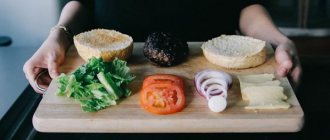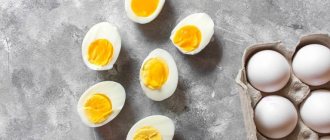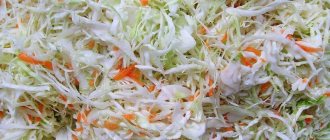When losing weight, you cannot completely exclude all types of bread products. During weight loss, it is necessary to prevent deficiency of vitamins and minerals in the body. When limiting the consumption of certain foods, a person begins to receive less nutritional components.
Nutritionists insist that eating bread is necessary. It is rich in a lot of vitamins and chemicals. However, not all types of food can be eaten while losing weight. The best solution is to make your own bread.
Calorie content
Wheat bread contains 213.6 kilocalories. The nutritional value, or the content of proteins, fats and carbohydrates, is 7.6/0.9/46.7 g. One bun (usually weighing 400 g) contains 1060 kcal. On average, 1 piece of bread contains from 50 to 70 calories.
The exact value of how many calories will be added can be found out by weighing 1 slice. Below are the calorie numbers depending on the type (per 100 grams):
| Types of flour products | Number of calories (kcal) | Composition of BJU (g) |
| White | 253,66 | 8,04/2,66/48,01 |
| Black | 208,29 | 7,12/1,57/39,55 |
| Rye | 250 | 13,0/3,0/40 |
| Grey | 254,66 | 8,97/2,71/48,24 |
| Borodinsky | 208 | 6,9/1 ,3/40,9 |
| Yeast-free | 221 | 6,9/1,2/43,4 |
| Bogorodsky | 220,8 | 6,8/1,05/45,74 |
| With bran | 227 | 7,5/1,3/45,2 |
| With buckwheat flour | 288 | 7,1/2,5/45,8 |
| Dietary | 214,9 | 5,6/1,9/45,3 |
Bread crumbs contain 331 kcal, 11.2 g of protein, 1.4 g of fat and 72.2 g of carbohydrates. Borodino contains the least amount of calories.
Table of carbohydrate content in foods
Eggs
Chicken eggsQuail eggsEgg whitesEgg yolksEggs with tomatoes
Any meat
MuttonBeefGoatmeatHorsemeatRabbitMeat semi-finished productsMeat by-productsGrilled meatPoultryPorkVealMind meatExotic meatMeat, gameSausage and sausage products
Semi-finished products
Ready pancakesReady dumplingsReady pateSourdoughFrozen cabbage rollsFrozen vegetablesCreamMarinadeMasticMeringueNut pasteReady dumplingsBrineSauce, pasteDry breakfastDry jellyDry cream for cakeDough
Fish
Red mullet DoradoIce fishLimonellaSea bassRiver fishGrilled fishFish with vegetablesGrounded fishSeabassSharkAnchoviesBelugaWomerLakedraCatfishFlounderMulletSpiratSmeltRed fishMackerelMacrurusOilfishSwordfishLampreyPollockCapelinFish milkSea whiteSolefish NototheniaSturgeonHalibutPangasiusPelengasHaddockWhite BlueFish FilletCanned FishVendaceSaurySardinesHerringMackerelStadridaTerpusTilapiaCodTunaEelTroutHakeSprotsNavaga
Seafood
AlgaeSquidCrabsShrimpMusselsShellfishSea CocktailSeaweedLobster, crayfishOctopusFish roeLangoustesKrill meat
Any cheese
Goat cheeseSausage cheeseSmoked cheeseSoft cheeseSheep cheeseProcessed cheeseBrine cheesePigtail cheeseBlue cheeseHard cheeseCurd cheese
Dairy
YoghurtKefirGoat's milk MatsoniMilk Yogurt RyazhenkaWheyCottage cheeseCondensed milkCreamSour cream
Mushrooms
Porcini mushrooms Oyster mushrooms Wheat mushrooms Bitter mushrooms Tree mushrooms Frozen mushrooms Chanterelles Marinated mushrooms Butter mushrooms Boletus mushrooms Aspen mushrooms Mushroom mushrooms Dried mushrooms Russula Truffles Champignons Shiitake Pork Morels Strings Mushrooms with onions Mushrooms with carrots Mushrooms with cheese Breast with mushrooms Cabbage with mushrooms Chicken with mushrooms
Vegetables
Avocados Artichokes Eggplants Bell peppers Rutabagas Daikon Zucchini Cactus Cabbage Potatoes Cress Lettuce Olives Carrots Cucumbers Dandelion Olives Fern Bracken Patisson Tomatoes Radicchio Radishes Turnips Bamboo shoots Dried vegetables Tarkin pepper Jerusalem artichoke Pumpkin Ramson Spinach Sorrel En diviEscaroleBeetsAsparagusChicken with vegetablesOnionsVegetables in sour creamOkra
Flour
Chickpea flour Rye flour Buckwheat flour Coconut flour Corn flour Flax flour Amaranth flour Oat flour Wheat flour Soy flour
Fruits
ApricotsQuinceCherry plumPineapplesOrangesWatermelonBananasGrapesPomegranateGrapefruitPearsDurianMelonFigsCarambolaKiwiDogwoodKumquatLimesLemonsLitchisMangoTangerinesPassionfruitPapayaPeachesPomeloFeijoaPersimmonRose hipsApplesPlums
Dried fruits
Raisins Dried apricotsDried cherriesDried figsDried applesDatesCandied prunesDried fruit mixture
Berries
HawthornLingonberriesElderberryCherryBlueberriesBlackberriesHoneysuckleFrozen berriesStrawberriesIrga ViburnumStrawberriesCranberriesGooseberriesRaspberriesCloudberriesSea buckthornRowanberryPhysalis Bird cherryCherryBlueberriesMulberriesGoji berriesCurrants
Nuts and seeds
PeanutsBrazil nutsWalnutsChestnutsPine nutsCashewsCoconutAlmondsPecanNut butterSeedsPine conesPistachiosHazelnutsChia seedsApricot kernels
Sweet
JamJamMarshmallowInvert syrupConfectionery toppingCandyConfitureXylitolMarmaladeMarzipanHoneyIce creamJamReady puddingSugarSyrupHalvaChocolateStevia
Cereals, cereals, cereals and grain products
BulgurBuckwheatQuinoaCornCouscousSemolinaOatsBranBarleySprouted grainsWheat groatsMilletRiceRyeFarroBarley groatsTapiocaOat fiberBarley
Pasta
VermicelliCannelloniNoodlesLasagne sheetsPastaSpaghettiPasta with mushrooms
Legumes
BeansVignaPeasSoyaTamarindBeansLentils
Bakery products
Ready-made tartletsCorn sticksWaffles Ready-made cakesMuesliCookiesGingerbreadCrusksBreadCerealChips
Spices, seasonings, seasonings
AdjikaAniseAniseBasilBarberryBouillon cubeVanillaGaram masalaClovesMustardOreganoJasmineGreen ZiraGingerHyssopItalian herbsCapersCardamomCurryChervilCilantro, corianderHemp grainCinnamonTurmericBay leafCitric acidMarjoramMelissaAlmond extractJuniper berriesNutmegM YataOreganoFenugreekParsnipsMiso PastePepperParsleyWormwoodMaggi SeasoningRosemaryCelerySaltSumacDry SpicesTanninTarragon, TarragonThyme, ThymeCarawayDillVinegarUtskho-suneliFennelHops-suneliHorseradishZestChicoryGarlicSageSaffron
Leaves, flowers, roots, bark
Chokeberry Grape leaves Ginseng Peel, bark Roots Nettle Lemongrass Rose petals Schisandra Blackberry leaves Strawberry leaves Currant leaves Onion peels Flax Rhubarb Milk thistle Malt Hops Linden flowers Chamomile flowers Celandine St. John's wort Beet tops Mix of herbs Cherry leaves Oak leaves Carrot bot va
Any fat
Cooking fatFat tail fatMayonnaiseMargarineVegetable oilLardChocolate oilPork fatButter
Alcohol
BrandyVermouthWineWhiskyVodkaGinCognacLiqueurInfusionBeerRumSakeCiderTequilaSherryChampagneAlcoholMoonshineAbsinthe
Other
Aspirin Birch buds Broth Water Soda Sodium glutamate Yeast Gelatin Jelly Liquid smoke Thickener Cocoa powder Kvass wort Kvass Compote Coffee Starch Carob Decoction Pepsin Baking soda Food coloring Popcorn Protein Baking powder Saltpeter Juice Dry kvass Tomato paste Coal Fructose Tea
Search:
GI:
| Product | Belkov, Mr. | Zhirov, g | Carbohydrates, g | Calories, kcal | GI |
| Wild rice raw | 59 | 10 | 275 | 353 | 57 |
| Buckwheat (whole grain) | 50 | 28 | 242 | 335 | 50 |
| Glass noodles | 0 | 0 | 86 | 351 | 65 |
| White fortified boiled rice | 9 | 1 | 85 | 109 | 60 |
| White rice, steamed, boiled with long grains | 8 | 1 | 85 | 106 | 60 |
| All-purpose whole durum wheat flour | 8 | 1 | 81 | 364 | 65 |
| Fortified whole durum wheat flour | 7 | 1 | 81 | 333 | 65 |
| Semolina flour | 10 | 1 | 80 | 348 | 40 |
| Rice | 7 | 1 | 79 | 344 | 57 |
| Mashed potatoes | 11 | 6 | 77 | 380 | 90 |
| White rice, steamed, with long grains, uncooked | 8 | 1 | 76 | 369 | 70 |
| White rice fortified raw | 8 | 1 | 76 | 363 | 70 |
| Pearl barley | 9 | 1 | 74 | 340 | 22 |
| Semolina | 10 | 1 | 73 | 340 | 65 |
| Instant dry rice | 8 | 3 | 73 | 374 | 94 |
| Uncooked brown rice | 8 | 3 | 73 | 360 | 50 |
| Light buckwheat flour | 13 | 1 | 72 | 347 | 40 |
| Dark buckwheat flour | 13 | 1 | 71 | 333 | 40 |
| Any jam | 0 | 0 | 71 | 271 | 70 |
| Pasta | 11 | 1 | 71 | 338 | 50 |
| Premium flour pasta | 11 | 1 | 71 | 338 | 50 |
| Pasta, premium, fortified | 10 | 1 | 70 | 337 | 55 |
| Pasta, premium, egg | 11 | 2 | 70 | 342 | 55 |
| Millet groats | 12 | 3 | 69 | 335 | 71 |
| Pasta made from 1st grade flour | 11 | 2 | 68 | 333 | 42 |
| Pasta, premium, dairy | 12 | 3 | 67 | 309 | 55 |
| Flour | 12 | 1 | 67 | 325 | 69 |
| Soy sauce | 6 | 0 | 67 | 51 | 35 |
| Buckwheat | 13 | 3 | 62 | 313 | 50 |
| Cakes | 5 | 6 | 62 | 318 | 63 |
| Shortcakes | 5 | 6 | 62 | 318 | 63 |
| Chickpeas | 19 | 1 | 61 | 364 | 35 |
| Dried apples | 2 | 0 | 59 | 210 | 30 |
| Bulgur | 12 | 1 | 58 | 342 | 48 |
| Prunes | 2 | 1 | 58 | 227 | 40 |
| Dried beets | 9 | 1 | 57 | 278 | 75 |
| Condensed milk with sugar | 7 | 9 | 56 | 324 | 80 |
| Pita | 9 | 1 | 56 | 277 | 70 |
| Dried carrots | 8 | 1 | 49 | 275 | 20 |
| Armenian lavash | 8 | 1 | 48 | 236 | 70 |
| White beans | 24 | 2 | 47 | 352 | 40 |
| Lentils | 26 | 2 | 46 | 340 | 25 |
| Dried uncooked lentils | 26 | 2 | 46 | 340 | 25 |
| Beans | 21 | 2 | 45 | 328 | 42 |
| Chia seeds | 17 | 31 | 42 | 512 | 30 |
| Dry yeast | 49 | 6 | 40 | 410 | 7 |
| Boiled buckwheat | 6 | 2 | 31 | 163 | 40 |
| Boiled brown rice | 3 | 1 | 30 | 119 | 50 |
| Garlic | 7 | 1 | 30 | 143 | 5 |
| Instant rice, ready to eat | 2 | 1 | 28 | 109 | 90 |
| Fried potato | 3 | 9 | 23 | 192 | 95 |
| Fresh frozen blueberries | 0 | 0 | 23 | 56 | 30 |
| Sweet potato | 2 | 0 | 20 | 86 | 50 |
| Boiled pasta | 3 | 5 | 19 | 135 | 60 |
| Canned apple mousse | 1 | 0 | 19 | 61 | 30 |
| Ripe potatoes | 2 | 0 | 18 | 80 | 45 |
| Choux pastry | 6 | 14 | 17 | 220 | 50 |
| Canned beans | 7 | 0 | 17 | 99 | 70 |
| Boiled potatoes | 2 | 0 | 17 | 82 | 70 |
| Persimmon | 1 | 0 | 17 | 53 | 45 |
| Jacket potatoes | 2 | 1 | 16 | 74 | 65 |
| Dry ginger | 2 | 1 | 16 | 347 | 5 |
| Ginger | 2 | 1 | 16 | 80 | 15 |
| Baked potatoes | 2 | 0 | 15 | 70 | 95 |
| Dried boiled lentils | 7 | 0 | 15 | 106 | 27 |
| Fruit cottage cheese | 18 | 1 | 14 | 147 | 35 |
| Red beans | 8 | 0 | 14 | 93 | 27 |
| Figs | 1 | 0 | 14 | 49 | 35 |
| Fresh frozen beans in packaging (300 g) | 19 | 0 | 13 | 102 | 30 |
| Fresh frozen black currant | 2 | 0 | 13 | 44 | 30 |
| Pickled ginger | 0 | 0 | 13 | 51 | 5 |
| Hulled sesame seed | 21 | 54 | 12 | 582 | 35 |
| Whole dried sesame seeds | 21 | 53 | 12 | 563 | 35 |
| Black currant | 1 | 0 | 12 | 38 | 30 |
| Boiled beets | 2 | 0 | 11 | 49 | 70 |
| Blueberry | 1 | 1 | 11 | 44 | 30 |
| Canned sausages | 42 | 175 | 10 | 228 | 5 |
| Crab sticks vici juicy | 6 | 1 | 10 | 73 | 40 |
| Crab sticks | 6 | 1 | 10 | 73 | 40 |
| Apples | 0 | 0 | 10 | 47 | 30 |
| Cottage cheese "Vitaliniya" | 7 | 0 | 9 | 64 | 35 |
| Beet | 2 | 0 | 9 | 40 | 64 |
| Pumpkin | 1 | 0 | 8 | 29 | 75 |
| Green cabbage | 1 | 0 | 7 | 46 | 10 |
| Carrot | 1 | 0 | 7 | 33 | 35 |
| Grapefruit | 1 | 0 | 7 | 29 | 22 |
| Crab sticks Santa Bremor snow crab | 9 | 1 | 6 | 70 | 40 |
| Green cabbage, fresh frozen in packaging | 1 | 0 | 6 | 45 | 10 |
| Cauliflower | 3 | 0 | 5 | 28 | 15 |
| Beef liver | 18 | 4 | 5 | 130 | 0 |
| Herring in sour cream | 6 | 6 | 5 | 97 | 0 |
| Beef liver | 18 | 4 | 5 | 130 | 0 |
| Zucchini | 1 | 0 | 5 | 23 | 15 |
| Boiled carrots | 1 | 0 | 5 | 25 | 85 |
| Fire red beans | 4 | 0 | 5 | 23 | 19 |
| Milk 2.5% fat | 3 | 3 | 5 | 54 | 20 |
| Whole cow's milk | 3 | 4 | 5 | 68 | 32 |
| Milk 1.5% fat | 3 | 2 | 5 | 47 | 30 |
| Milk 3.5% fat | 3 | 4 | 5 | 64 | 25 |
| Milk 3.2% fat | 3 | 3 | 5 | 60 | 25 |
| Condensed milk 7.5% fat | 3 | 8 | 5 | 140 | 40 |
| Herring in tomato sauce | 14 | 10 | 5 | 159 | 0 |
| White fried | 15 | 7 | 5 | 162 | 15 |
| Cottage cheese "morning" ("danone") without sugar | 7 | 5 | 4 | 91 | 30 |
| Full fat kefir | 3 | 3 | 4 | 62 | 20 |
| Kefir "Doctor Beefy" 1.8% - fat content | 3 | 2 | 4 | 45 | 15 |
| Salmon sauté | 21 | 31 | 4 | 379 | 5 |
| Kefir 2.5% fat | 3 | 3 | 4 | 53 | 15 |
| Kefir 1% fat | 3 | 1 | 4 | 38 | 15 |
| Low-fat cottage cheese | 16 | 1 | 4 | 75 | 30 |
| Miramar crab sticks | 15 | 7 | 4 | 140 | 40 |
| Crab sticks meridian snow crab | 15 | 7 | 4 | 140 | 40 |
| Cheese "cheese "chavrou" (goat) | 9 | 14 | 4 | 173 | 0 |
| Pork liver | 19 | 4 | 4 | 109 | 0 |
| Low-fat kefir | 3 | 0 | 4 | 30 | 15 |
| Tomatoes | 1 | 0 | 4 | 23 | 10 |
| Green beans | 2 | 0 | 4 | 24 | 30 |
| Pickled herring | 17 | 13 | 3 | 192 | 5 |
| Chinese cabbage | 1 | 0 | 3 | 16 | 15 |
| Sour cream | 3 | 20 | 3 | 210 | 30 |
| Sour cream 20% fat content | 3 | 20 | 3 | 210 | 0 |
| Sour cream 30% fat content | 2 | 30 | 3 | 340 | 0 |
| Asparagus | 2 | 0 | 3 | 20 | 15 |
| Mozzarella | 28 | 24 | 3 | 280 | 0 |
| Ricotta | 11 | 8 | 3 | 174 | 0 |
| Sour cream 10% fat content | 3 | 10 | 3 | 115 | 0 |
| Cottage cheese 18% fat | 14 | 18 | 3 | 226 | 30 |
| Sour cream 25% fat content | 3 | 25 | 3 | 284 | 0 |
| Cottage cheese 40% fat | 28 | 40 | 3 | 466 | 35 |
| Fresh cucumbers | 1 | 0 | 3 | 15 | 25 |
| Pork tongue | 16 | 16 | 2 | 300 | 0 |
| Spinach | 3 | 0 | 2 | 22 | 15 |
| Cream cheese 50% fat | 18 | 50 | 2 | 349 | 5 |
| White pickled | 3 | 1 | 2 | 24 | 15 |
| Processed cheese 60% fat content | 18 | 60 | 2 | 354 | 0 |
| Processed cheese 45% fat content | 18 | 45 | 2 | 294 | 0 |
| Cheese "viola" | 11 | 28 | 2 | 307 | 0 |
| Salted cucumbers | 1 | 0 | 2 | 11 | 15 |
| Milk sausages | 11 | 24 | 2 | 266 | 28 |
| Cottage cheese with sour cream | 18 | 14 | 2 | 260 | 35 |
| Fried squid | 10 | 14 | 1 | 175 | 0 |
| Chicken liver | 20 | 6 | 1 | 140 | 35 |
| Cottage cheese 20% fat | 14 | 20 | 1 | 233 | 30 |
| Cod liver in oil | 4 | 66 | 1 | 613 | 30 |
| Forest mushrooms | 3 | 1 | 1 | 21 | 10 |
| Fresh porcini mushrooms | 4 | 2 | 1 | 34 | 10 |
| Soft dietary cottage cheese | 16 | 11 | 1 | 170 | 25 |
| Chicken heart | 16 | 10 | 1 | 159 | 0 |
| Chicken, flesh without skin | 18 | 18 | 1 | 241 | 0 |
| Salmon from the grill | 21 | 22 | 1 | 283 | 0 |
| Quail egg | 12 | 13 | 1 | 168 | 0 |
| Turkey carcass without skin | 20 | 8 | 1 | 161 | 0 |
| Smoked trout | 26 | 3 | 1 | 132 | 0 |
| Chicken breast | 24 | 2 | 0 | 113 | 0 |
| Chicken breast (fillet) | 24 | 2 | 0 | 113 | 0 |
| Egg | 13 | 11 | 0 | 80 | 0 |
| Tongue sausage | 16 | 10 | 0 | 215 | 0 |
| Champignon | 4 | 1 | 0 | 24 | 15 |
| Roast duck | 23 | 35 | 0 | 401 | 0 |
| Mixed minced meat | 12 | 32 | 0 | 351 | 0 |
| Pork | 16 | 22 | 0 | 259 | 0 |
| Boar ham | 18 | 18 | 0 | 113 | 0 |
| Pork shoulder | 15 | 29 | 0 | 593 | 0 |
| Pork - schnitzel | 15 | 29 | 0 | 352 | 0 |
| Pork chop on the bone | 21 | 10 | 0 | 537 | 0 |
| Pork - lean roast | 16 | 28 | 0 | 184 | 0 |
| Pork is fatty | 15 | 30 | 0 | 333 | 0 |
| Pork meat | 14 | 33 | 0 | 357 | 0 |
| Corned beef | 19 | 25 | 0 | 216 | 0 |
| Rendered beef fat | 0 | 100 | 0 | 871 | 0 |
| Boiled ham | 14 | 26 | 0 | 269 | 0 |
| Beef - tail | 20 | 7 | 0 | 184 | 0 |
| Beef - ham | 20 | 3 | 0 | 104 | 0 |
| Fatty beef | 20 | 23 | 0 | 171 | 0 |
| Lean beef | 22 | 7 | 0 | 158 | 0 |
| Beef - ribs | 16 | 19 | 0 | 233 | 0 |
| Beef - shoulder | 19 | 7 | 0 | 137 | 0 |
| Beef - lean roast | 20 | 6 | 0 | 200 | 0 |
| Beef - sirloin | 20 | 4 | 0 | 380 | 0 |
| Beef - brisket | 19 | 16 | 0 | 217 | 0 |
| Fresh squid | 18 | 0 | 0 | 74 | 0 |
| Boiled squid | 18 | 4 | 0 | 110 | 0 |
| Chickens | 19 | 7 | 0 | 140 | 0 |
| Chicken II category | 21 | 8 | 0 | 159 | 0 |
| Chicken I category | 18 | 18 | 0 | 238 | 0 |
| Turkey II category | 86 | 108 | 0 | 194 | 0 |
| Lightly salted trout | 18 | 19 | 0 | 186 | 0 |
| Boiled trout | 16 | 3 | 0 | 89 | 0 |
| Trout | 19 | 2 | 0 | 97 | 0 |
| Cottage cheese | 16 | 10 | 0 | 156 | 30 |
| Cottage cheese 10% fat | 16 | 10 | 0 | 156 | 0 |
| Fresh mackerel | 19 | 12 | 0 | 181 | 0 |
| Boiled mackerel | 20 | 15 | 0 | 211 | 0 |
| Smoked mackerel | 21 | 16 | 0 | 221 | 0 |
| Fresh tuna | 23 | 1 | 0 | 101 | 0 |
| Tuna in its own juice | 21 | 1 | 0 | 96 | 0 |
| Tuna in vegetable oil | 27 | 9 | 0 | 190 | 0 |
| Fresh pollock | 16 | 1 | 0 | 72 | 0 |
| Boiled pollock | 18 | 1 | 0 | 79 | 0 |
| Fresh salmon | 22 | 6 | 0 | 140 | 0 |
| Boiled salmon | 23 | 13 | 0 | 189 | 0 |
| Steamed salmon | 19 | 14 | 0 | 197 | 0 |
| Salted pink salmon | 22 | 9 | 0 | 169 | 0 |
| Fresh pink salmon | 21 | 7 | 0 | 142 | 0 |
| Boiled pink salmon | 23 | 8 | 0 | 168 | 0 |
| Salted salmon | 21 | 21 | 0 | 269 | 0 |
| Fresh salmon | 20 | 6 | 0 | 201 | 0 |
| Smoked salmon | 22 | 8 | 0 | 162 | 0 |
| Salmon mince | 19 | 6 | 0 | 130 | 0 |
| Duck liver | 16 | 38 | 0 | 405 | 0 |
| Goose liver | 15 | 39 | 0 | 412 | 0 |
| Beef liver | 15 | 4 | 0 | 735 | 0 |
| Lamb liver | 19 | 3 | 0 | 101 | 0 |
| Lean lamb | 18 | 11 | 0 | 169 | 0 |
| Fatty lamb | 18 | 30 | 0 | 225 | 0 |
| Lamb - back part | 17 | 21 | 0 | 459 | 0 |
| Lamb - shoulder | 16 | 25 | 0 | 284 | 0 |
| Lamb - brisket | 14 | 26 | 0 | 533 | 0 |
| Lamb - ham | 18 | 18 | 0 | 232 | 0 |
| Lamb - chop on the bone | 14 | 25 | 0 | 380 | 0 |
| Boiled bacon | 16 | 14 | 0 | 447 | 0 |
| Salted herring | 20 | 15 | 0 | 217 | 0 |
| Fresh herring | 16 | 11 | 0 | 161 | 0 |
| Hot smoked herring | 22 | 14 | 0 | 215 | 0 |
| Herring in vegetable oil | 16 | 27 | 0 | 301 | 0 |
| Pork ribs | 15 | 29 | 0 | 321 | 0 |
| Pork knuckle | 19 | 25 | 0 | 294 | 0 |
| Boiled mussels | 9 | 2 | 0 | 50 | 0 |
| Fried mussels | 11 | 2 | 0 | 59 | 0 |
| Smoked chicken | 18 | 5 | 0 | 117 | 0 |
| Fresh shrimp | 22 | 1 | 0 | 97 | 0 |
| Frozen peeled shrimp | 14 | 1 | 0 | 60 | 0 |
| Boiled shrimp | 19 | 2 | 0 | 95 | 0 |
| Canned shrimp | 18 | 1 | 0 | 81 | 0 |
| Calf tongue | 14 | 12 | 0 | 160 | 0 |
| Beef tongue | 12 | 11 | 0 | 146 | 0 |
| Linseed oil | 0 | 100 | 0 | 898 | 0 |
| Duck category I | 16 | 38 | 0 | 405 | 0 |
| Duck category II | 17 | 24 | 0 | 287 | 0 |
| Pork belly | 21 | 7 | 0 | 155 | 0 |
| Russian sausages | 11 | 22 | 0 | 243 | 0 |
| Pork sausages | 12 | 31 | 0 | 324 | 0 |
| Chicken legs | 17 | 10 | 0 | 158 | 0 |
| Chicken mince | 17 | 8 | 0 | 143 | 0 |
| Boiled halibut | 14 | 18 | 0 | 216 | 0 |
| Fresh halibut | 19 | 3 | 0 | 102 | 0 |
| Megle cheese | 37 | 41 | 0 | 590 | 0 |
| Tartar cheese | 26 | 27 | 0 | 348 | 0 |
| Turkey fillet | 19 | 1 | 0 | 84 | 0 |
| Tuna canned in its own juice | 21 | 1 | 0 | 96 | 0 |
Without a doubt, the caloric content of food in general and the table of caloric content of foods in particular are of interest to a huge number of people who are accustomed to monitoring their own weight. There are a large number of various resources on the Internet that offer to count calories in foods. You can find out how many calories are in a product from the calorie content database we have collected, which is constantly being added. Then you can take this into account when preparing various dishes according to your own recipes or look at our website: from the composition of the culinary recipe presented to us, you can see exactly what products are included in it or another recipe. Next, a table of calorie content of food products is displayed, taking into account the varieties and varieties of all possible food options. Since the calorie content of food depends not only on the variety, composition, but also on the manufacturer. Each recipe presented on our website has a description of the calories it contains. There are calories in everything, even in a spoon of dry tea (although there are very, very few of them). That is why it is important to have information about the possible total calorie content of foods. For some people, the table of caloric content of foods becomes literally a reference book or rather an application. On our website you can find out the calorie content by determining it using the table of calorie content of foods. To do this, just go to the desired section with the name of a particular product. Remember to regulate your calorie intake is simply necessary if you want to maintain the balance of your weight or change it in one direction or another. Even if you consume the healthiest foods above the amount of calories your body needs, you will gain weight. If you want to manage your weight without harming your health, watch the calorie content of the food you consume.
Composition and beneficial properties
When consuming bread products, the body receives fiber, which helps improve the functioning of the digestive organs. When losing weight, a person experiences stress. The cereal product normalizes the nervous system.
Therefore, you should not completely give up bread. The most useful is rye. It contains many healing components, as well as the following vitamins:
- retinol;
- tocopherol;
- lipophilic compounds (vitamin K).
Chemical composition of bread:
- iodine;
- sodium;
- manganese;
- chlorine;
- potassium;
- zinc;
- silicon;
- selenium;
- magnesium;
- copper;
- cobalt.
If you deprive the body of the minerals and vitamins found in bread, this will lead to increased fatigue, short temper, and depressive disorders.
Slow carbohydrates and amino acids stimulate muscle growth. Other beneficial properties of flour products include:
- lack of fast carbohydrates;
- content of substances necessary for the heart (magnesium, potassium);
- high energy value;
- long-term absorption.
Macro and microelements in bread
High-quality bread contains the necessary macro- and microelements, as well as vitamins, which ensure the full functioning of the body.
The greatest amount of useful substances is found in products with bran or made from whole grain flour.
The daily intake of bread contains the maximum amount of selenium. This microelement is necessary for the full functioning of various biochemical processes.
When whole grains are included in the diet daily, up to 30% of manganese is replenished, which acts as an antioxidant necessary for metabolic processes in mitochondria.
In addition, with sufficient intake, metabolic processes with carbohydrates, proteins and cholesterol are restored. Bread can provide up to 5% of the daily value of such substances as calcium, phosphorus, iron, magnesium, sodium, zinc and copper.
Bread for weight loss
White bread made from premium flour contains a lot of starch and calories. After consuming such products, insulin is produced and a sharp drop in sugar occurs, which causes an acute feeling of hunger. As a result, a person begins to eat more and overeating occurs.
To lose weight, you need to choose baked goods with the following additives (the listed varieties contain a lot of healthy fiber):
- linen;
- buckwheat grains;
- sunflower seeds;
- millet;
- oats;
- carrot;
- onion;
- pumpkin;
- paprika.
Black and gray bread with rye flour is absorbed more slowly by the body. It is useful to eat rye bread with other products that are present in a weight loss diet. This way saturation will happen faster.
By consuming flour products, you can cleanse the body of harmful metabolic products and carcinogens; bread is also low in calories. You can reduce the calorie content even further if you buy it from flour made from legume grains, such as peas and corn.
How to replace the product
Bread can be replaced with fruits, fresh vegetables and herbs. But these foods will not make you feel full.
If necessary, you can replace the bread:
- biscuits;
- bread;
- bran.
What happens if you completely give up bread?
With a complete and rapid refusal of carbohydrates, the development of pathological reactions from the body is possible. Among them are:
- Incessant headache. A complete refusal of bread can lead to a lack of carbohydrates in the body, from which glucose is produced, which is a source of energy. The brain is one of the organs that primarily responds to a lack of nutrients.
- Constant fatigue due to insufficient energy supply.
- Tendency to depression. Low glucose levels cause insufficient serotonin production. In the initial stages, the patient may experience depressed mood and constant anxiety, which is replaced by unmotivated aggression and depression.
- Disorders of the digestive tract. Avoiding bread leads to insufficient fiber intake. As a result, intestinal motor function decreases and the likelihood of fermentation and dysbacteriosis increases.
- Constant feeling of hunger. Lack of glucose in the body leads to a constant feeling of hunger. To reduce the severity of this symptom, it is necessary to consume a sufficient amount of complex carbohydrates.
- Hormonal imbalance.
Is it possible to eat bread when you are losing weight?
Most people who decide to lose weight first eliminate or minimize the amount of bread from their diet. Complete cessation of its use leads to a negative effect on the body.
This diet product is capable of:
- Positively influence digestive function due to fiber. As a result, waste and toxins are removed.
- Stimulate the breakdown of fats, since the process of their destruction is triggered by carbohydrates. In addition, in addition to simple carbohydrates, the composition also contains complex carbohydrates. They provide a feeling of fullness for a long time.
- Replenish the amount of vegetable protein, which acts as a building material for cells, as well as vitamins and minerals.
- Produce endorphins and serotonin due to the taste of the product. It is necessary to take into account that different types of bread have different glycemic index - an indicator indicating the duration of absorption of the product. When dieting, it is important to select varieties with a low glycemic index, which are absorbed from the digestive tract for a long time and do not provoke appetite. These include Borodinsky or whole grain bread, while white bread must be completely abandoned.
In addition, to lose weight, you must follow several basic rules when consuming baked goods while losing weight. Among them are:
- Elimination of other carbohydrates when including bread in the diet. To reduce body weight, it is recommended to combine it with protein foods.
- Limit a single dose to 100 grams, in order not to exceed the permissible number of calories.
- Avoid product in the evening.
- Creation of fasting days with its complete exception.
Is there a universal norm?
In fact, everything is purely individual. To find out how much bread you can eat, first of all you need to understand your individual needs for KBZHU (calories, proteins, fats, carbohydrates). It is calculated based on a person’s goals and personal physiological parameters.
Photo: istockphoto.com
For example, let’s take a 30-year-old woman with a height of 160 cm and a weight of 65 kg who does not play sports. The woman’s goal is to lose 5 kg. Let's calculate her needs.
How to calculate your daily calorie needs?
Various formulas are used for calculation, but the Mifflin-Saint-Geor formula is considered to be recognized by the Association of American Dietitians:
For women:
(10 × weight in kilograms) + (6.25 × height in centimeters) − (5 × age in years) − 161.
For men:
(10 × weight in kilograms) + (6.25 × height in centimeters) − ( 5 × age in years) + 5.
Physical activity also needs to be taken into account. If you do not have physical activity and have a sedentary job, multiply the result by 1.2. If you jog or do light exercise 1-3 times a week, multiply by 1.375. If you do moderate exercise 3-5 times a week, multiply by 1.55. If you train fully 6-7 times a week, multiply by 1.725. If your job involves physical labor, you train twice a day and include strength exercises in your training program, your coefficient will be 1.9.
Now we count: (10*65 + 6.25*160 – 5*30 – 161) * 1.2 = 1606 kcal.
Photo: istockphoto.com
This turned out to be the woman's need for calories in order to maintain her current weight. For comfortable and safe weight loss, she should reduce calories by 250 kcal and consume an average of 1350 kcal per day.
Types of products
There are many varieties of bread sold on store shelves, which differ in composition and preparation recipe. Today the following options are most in demand:
- - a product of Georgian cuisine. In the process of its preparation, only two ingredients are used - water and flour. Thanks to this, the product has minimal thickness and a bland taste.
- Lunch
is a loaf that is prepared according to a classic recipe using familiar ingredients (water, flour, salt and yeast). During the cooking process, special additives can be added that improve the structure of the product, but do not change its composition. - Matzo
is a kind of pita bread that has a slightly different shape and taste. In this case, matzo is also prepared using water and flour. - Naan
is a flatbread originally from the East, which is often mistakenly called pita bread. - Chapatis
are breads from India that contain only water and flour. During the cooking process (frying in a frying pan), the products swell and receive their final shape.
GRAIN OF TRUTH[edit | edit code]
Source Muscle and Fitness Magazine 2011 No. 2
Which bread is the healthiest? The one you baked yourself!
For a long time, humanity determined the quality of flour by its color: the whiter the better. From the same wheat you can make different types of flour, including premium. The main thing is to have a fine sieve on hand. Careful sifting removes the grain shells from the flour and leaves us with pure white starch. It contains a lot of calories, but little benefit, since together with the “husk” the original product (wheat) loses the vast majority of its nutritional value due to the destruction of vitamins, microminerals, healthy unsaturated fats and fiber. However, our ancestors did not delude themselves about the usefulness of white flour. Baking from it was considered a delicacy. It was supposed to be eaten only on holidays, and during Lent, white bread was considered a forbidden product along with meat. Well, only bread made from coarse flour was recognized as everyday food, giving strength and health.
Today we are rediscovering old truths and starting to bake the so-called again. whole wheat bread. There are more and more people aware of the benefits of such bread, and therefore this previously rare product has already become the subject of big business.
It would seem that it could be simpler than buying a loaf of black bread. However, don't be fooled by the color difference. This type of bread is baked from first or even higher grade flour, mixing white wheat and dark rye flour.
You need bread that says so directly on the label: whole grain. This means that when baking, the so-called. wholemeal wallpaper flour. Moreover, other manufacturers add even more vegetable fiber, crushed seeds and nuts to this flour.
We need to make a reservation right away: we bodybuilders only accept whole grain products, including baked goods. Wild rice, oatmeal (not to be confused with oatmeal!), legumes, vegetables and fruits are those “slow” carbohydrates that maintain high muscle tone throughout the day. As for “fast” carbohydrates, such as sugar, white bread, pastries, jams, white rice, etc., we take them only after training, when we need to quickly saturate tired muscles with glucose. The rest of the day, “fast” carbohydrates are not good for us. They cause a quick burst of energy due to a sharp increase in blood sugar levels, which is immediately replaced by drowsiness and loss of energy. The reason is that the same white bread provokes a strong secretion of the hormone insulin. It is released to “pick up” excess sugar from the blood and deliver it directly to the muscles. It would seem good, but too much insulin is released. It almost completely clears the blood of sugar, and the resulting weakness becomes a signal for the release of the catabolic hormone cortisol. It begins to “burn” muscles to save the brain from a dangerous energy deficit.
Anyway, let's get back to whole grain bread. Manufacturers sell it at a higher price and in most cases are desperately disingenuous. They use regular flour, adding very little wholemeal flour to it. How to be? We strongly advise you to buy a bread machine for home. This simple device bakes bread for you and will never deceive you. As for wholemeal flour, there is plenty of it on the market. Moreover, not only wheat, but rye, oatmeal, barley, buckwheat and even peas. Mix flour and you will get the healthiest bread, which is guaranteed to extend life by 10-15%. In your case, we will talk about sports longevity. Isn’t it great to set records in the bench press even after forty?
Bread for the elderly
For elderly people, it is necessary to carefully consider the preparation of the daily menu. In many ways, nutritional habits change due to age against the background of acquired diseases and changes in the functional activity of the digestive tract.
First of all, it is necessary to take into account the presence of acquired pathologies. Among them, the most common are type 2 diabetes mellitus, colitis and gastroduodenitis of various origins.
Diabetes requires daily menu control, and white bread and various baked goods have a high calorie content due to simple carbohydrates.

